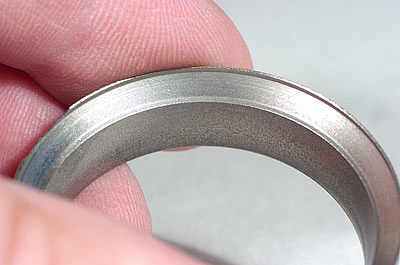Ruthless Pursuit of Power: Our In-Depth Look at the 2008 Corvette LS3 Engine - Page 5 of 6
Ruthless Pursuit of Power: 2008 Edition - Page 5 of 6
Our In-Depth Look at the New 2008 Corvette LS3 Engine
 |
 |
© 2007 by Hib Halverson
No use without permission, All Rights Reserved
![]() Discuss this article
Discuss this article
The best combustion quality occurs when the air fuel mixture in the chamber is distributed uniformly, or is "homogenous", throughout the chamber. The process of becoming homogenous, or as close to it as possible, occurs in the latter stage of the intake valve event and continues once the valve is closed and the piston starts upward. Not only does the upward piston movement compress the air-fuel mix but it also causes it to swirl and tumble and that further mixes it up making it more homogenous. The LS2/LS6 chamber had great swirl but not very good tumble. The air fuel mix needs to be doing both if the goal is homogenity right when the spark comes.
The bulge in the LS3 chamber exists solely to get the air-fuel mix to tumble more as the piston nears the point at which the spark lights that mixture. The bulge is also responsible for a slight increase in chamber volume, from 64.75 cc. on LS2 to 68.7 cc . on LS3, and that is part of the small compression loss compared to LS2.
"The flow numbers," an understandably proud Lou Oniga told us, summarizing the new head, "are (average) 17% improvement on the intake and 6.2% on the exhaust."
"That's very impressive." Rydzewski continued. "(The intake port has) more of a straight path, right down to the valve and that was very important to air flow. Lou did a good job, taking what the race guys came up with then refining that-tweaking it in our airflow facilities-to get where it is with LS3. It's a great high-volume cylinder head design which performs very well."
Stout Head Structure
The LS3 head has more than just great airflow. Since the big change in port configuration would drive changes in the core boxes used to cast the head, Powertrain took the opportunity to alter the head's structure for improved reliability/durability.
"We did extensive finite element analysis (FEA)", Lou Oniga stated. "We have an outstanding analysis group which was able to take our Unigraphics models and then utilize NASTRAN formulae for very detailed FEA."
Computer analysis and simulation software has become indispensable to engineering not only at General Motors, but industry-wide. Powertrain utilizes this software to perform analysis of its designs and to simulate engine tests, such as GED (Global Engine Test Durability Cycle), GTEC (General Engine Thermal Cycle) and PTED (Power train Engine Durability) all severe durability test schedules simulating 150,000 miles of abuse by a 95th percentile customer.
Obviously, such software tools require lots of computer power to run and, thus, are very costly but the costs are recovered many times over because analysis and simulation allows GM to bring its products to market faster. Some call this "from art to part", meaning that parts can make it from math art to production with less prototypes and less physical testing, but we emphasize: never to the point of no testing.
"We discovered that the exhaust manifolds have a tendency to grow significantly during the first thermal cycle and distort the end faces of the cylinder head," Oniga continued. "The intake side expands very little but the exhaust face grows significantly.
"Because of this distortion, we took the cup plugs out of the ends of the head. People believe those are 'freeze plugs,' but they're not. The hole’s primary purpose is to support the water jacket core inside the cylinder head so when molten aluminum flows into the mold, the water jacket core doesn't float or move around while the casting solidifies.
Examine earlier heads other than for LS7s and you'll see the bores into which these plugs go are pretty good sized-about one inch diameter. The structure of the head in the areas adjacent to the exhaust manifold ends is not as stiff with those holes in it as it would be if those surfaces were continuous.
"We developed a new way to support the water jacket core through the deck face, locking it to the combustion chamber portion of the dies used to form the casting," Lou Oniga stated. "We got rid of the holes, which eliminates a potential leak path, eliminates a part-always good from a cost standpoint-and strengthens the structure of the cylinder head.
"We were able to run this head through multiple, detailed FEA analyses. We, improved the internal strength of the head with a more robust water jacket core. It has what I call the 'super jacket' which has excellent strength and a higher safety factor, but doesn't use much more metal internally than the current LS2 head.
"The valve seats are also more robust. The material still in production (at the time of this interview, mid-May '07) is a powdered metal, tool steel with some molybdenum-disulfide and traces of other metals.
"The Small-Block does not have water flowing completely around the valve seat inserts. When things get extra hot, you want fast heat transfer away from the valves and valve seats and into the water jacket. Because we did not have the luxury of adding water jacket cavities completely around the valves, we decided to employ a copper-infiltrated valve seat insert.
"The supplier, Federal-Mogul, takes a powdered metal blank and puts a copper cap over it. They run it though an oven, the copper melts and wicks into the voids of the powdered metal. Powdered metal has microscopic cavities into which this copper infiltrates. The main difference between the two inserts is the exhausts have more copper because they run hotter. The intakes can get by with less because they run cooler due to fuel spray and cool air flowing past them.
"Heat transfer increased significantly. We were able to get 4-6% faster heat transfer, out of the valves, though the seats and into the water jacket. Also, the added copper is easier to machine, so cutting tools used to machine them last longer.
"We invested in new, capital equipment. Obviously, because the valves are larger, we had to buy several new pieces of transfer equipment to cut the valve seats as well as other unique features. This allowed simultaneous engineering with the manufacturing engineering group permitting improvements in machining technology and increased accuracy."
The new machining processes made practical more stringent specifications for the surface quality of the head's deck and exhaust manifold faces. In North America, the American National Standards (ASNI) Institute sets standards for geometric dimensioning and tolerancing (GD&T) and ASNI recently adopted tighter finish and flatness requirements, specifically: Rz (average roughness), Rmax (maximum roughness), and Wt (maximum peak to minimum peak of the roughness range), all of which are surface finish benchmarks used by the metal working industries.
The application of new machining processes improved sealing between head, gasket and block along with that between head, exhaust gasket and exhaust manifold. We should point out, however, that we're "splittin' hairs," here, because the quality of these surfaces on previous engines was already very good. Apparently, they now are even better, but the improvement is incremental-we're talking less than a thousandth of an inch.
"The surface finish achieved is not unlike the surface of a compact disc-it is that smooth," Lou Oniga added. "This permits a 'designed-in' amount of relative sliding movement between the block, gasket, and cylinder head, keeping gasket wear and tear at a minimum during the millions of thermal cycles which will occur during the engine's life."
The reason for that seemingly small but important change is, as Oniga told us, "Deck and exhaust face surface finish and flatness are very critical when using modern, multi-layer, steel (MLS) cylinder head and exhaust manifold gaskets."
In conjunction with the surface finish enhancements, through 2006 and the first half of '07, Powertrain researched head gasket designs then released a new, 5-layer gasket for LS3-as opposed to a 3-layer gasket on LS2.
Serious engine sealing geeks work at GMPT and, over lunch, they talk about "gap amplitude." Combustion pressure pushes the head up. No matter how much clamp load the head bolts provide; that head wants to lift. The lift is called "gap amplitude" and the cylinder head gasket has to be able to fill or conform to it. If the lift exceeds the gasket's conformal capability; you get a leak. Even a short duration, small leak and exhaust gases start blowing by or coolant leaks. The LS3 gasket's two extra layers offer better sealing.
Another requirement for LS3 was the same or better oil flow though the head's oil drain cavity. The increase in port size took a bite out of the existing oil drain volume. The Small-Block team didn't want to shrink that passage, so they changed its shape to keep the same surface area and that made yet another change in the head's architecture.
Finally the rocker cover rail has a bigger sealing land. There's more material all the way around it. With FEA studies, GMPT learned the head was twisting a little. Bulking-up the sealing land stiffened the rocker cover area and provided a more robust seal.
 |
 |


